This post was last updated on November 18, 2022 by Preethi Sukumaran
Did you know that an Ayurvedic bath / Snana has multiple benefits? It can deep cleanse skin, re-set dosha aggravation, reduce strong body odour, keep the body feeling cool and refreshed longer, improve the thermo-regulatory function of skin and also stimulate the appetite and improve nutrient absorption? How does an ayurvedic bath offer so may benefits? What is the difference between this and a regular bath / shower? What ayurvedic bath products can one use for a good Snana? For this and more, let us delve into today’s blog post.
Chaitra Navaratri and Goddess Maha Gauri:
The 8th day of Chaitra Navratri is dedicated to Goddess Maha Gauri (Gauri means white). Goddess Maha Gauri is depicted as beautiful with a shining, white-gold complexion. She is dressed in white and holds a lotus, a trident and a small drum in three hands while the fourth hand blesses her devotees. She rides a white bull and is dressed completely in white.
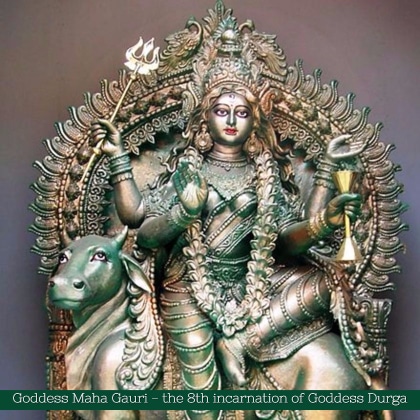
In mythology, Goddess Maha Gauri is said to relieve all the sufferings of her devotees and fulfil all their deepest desires.
How Goddess Maha Gauri came to be:
Goddess Parvati is also referred to as “Aparna” or the Lady of the terrible penance in Hindu mythology. The story goes that she tried to attract God Shiva’s attention through her beauty and service to him. She was assisted by Lord Kamadeva and his wife Rati in the endeavour. When Lord Shiva felt his concentration waning and found that he was not paying attention to his penance and was instead disturbed by thoughts of the Goddess Parvati, he understood that Kamadeva was at play.
So Lord Shiva opened his third eye and incinerated Lord Kamadeva for distracting him from his penance.
Now Goddess Parvati decided to throw all her faith behind intense penance and focus. She did tapas for thousands of mortal years standing neck deep in cold water, standing inside a fire and did her penance through storms, hail, floods, droughts and intense heat. She was so lost in her penance that years went by and anthills and forests grew around her. She was so devoted to her penance that she was referred to as “Aparna”, the Lady of the terrible penance.
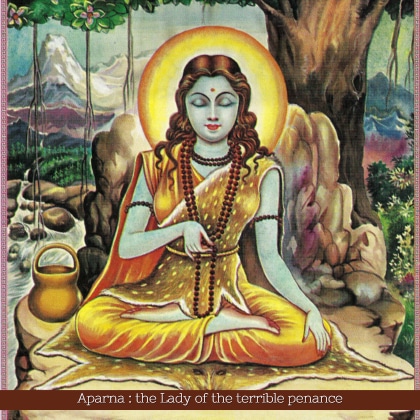
Finally, moved by her severe penance, Lord Shiva appeared to Goddess Parvati and promised to marry her.
The Divine Abhyanga and Ayurvedic Bath of Goddess Parvati
After the Goddess’ long and terrible penance where she had braved the elements, her entire body was covered with dust, soil, earth and leaves of the trees and mud from the anthills that surrounded her. Her body was covered in a thick, dark, muddy layer.
It was said that Lord Shiva himself requested Ganga sitting on his head to appear and wash away the dirt, soil and mud from the Goddess’ body. It was said that this divine, purifying bath transformed “Aparna” to “Maha Gauri”.
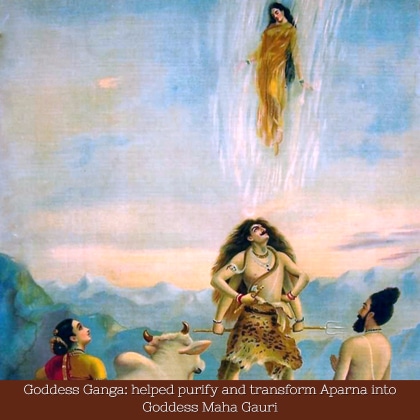
Ayurvedic Bath / Snana (Daily Morning Bath) is a Nithyakarma:
Our cultural myths, allegories and stories and rituals help us go deeper and deeper into the significance of the things we do for ourselves and for our families. Ayurveda prescribes several “Nithyakarmas”. These are spiritual and sacred acts that are to be done “Nithya” or everyday by us for health, well being and prosperity.
Living a life of temperance and good conduct is a Nithyakarma, as is the act of bathing every single day within the first few hours of sunrise.
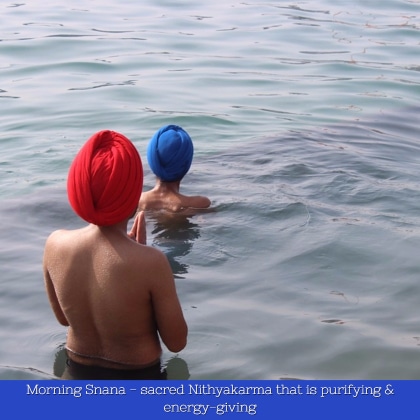
The morning bath is specific to India and tropical counties and forms a part of our prescribed Nithyakarma. This bath is considered a sacred and inviolable start to the day and is considered both spiritually and physically purifying and cleansing to the body. The daily Snana / Ayurvedic bath is such an essential Nithyakarma that we are traditionally not supposed to eat or drink anything, cook, offer prayers , do yoga, or start our office work before completing the Snana.
The benefits of the Daily morning ayurvedic bath
“Bathing is purifying, life promoting, a destroyer of fatigue, physically removes sweat and dirt, is resuscitative and a promoter of ojas or divine energy” : Charaka Samhita – Sutrasthana shloka on Dinacharya
The Ayurvedic texts recommend eating with the sun. So generally the last meal of the day is best had as close to sunset as possible – in practice we recommend eating before 8:30 pm. A gap of 2 hours is advised post eating to allow the body to complete digestion. So if we go to sleep by 10:30 after completing our last meal by 8 pm, our body would have completed digestion before we sleep.

As we sleep, our body goes into a process of repair and renewal. Every organ system has a specific time when it is renewed. This time is fixed and is not changed. The most important thing to understand here is the digestion takes precedence over repair and renewal. So if you eat late, you are taking away an organ system’s chance to repair and renew itself.
Waste / Mala is the by product of all digestion, repair and regeneration in the body. Every single organ system sheds excess, and removes Mala from the body. Every single day cells die and are born in the body. A part of Mala is also the debris of these dead cells which must all be transported out of the body for good health.
Health issues and dis-ease when Mala is not periodically removed from the body:
Ayurveda traces the genesis of most diseases to the accumulation of Mala in the body. Mala can accumulate as a by product of eating, because of poor sleep and because of poor habits.
When we eat food that is not suitable to our prakriti, or we eat too late, or we eat in quantities that are not suitable to us, we dampen the Agni in our body. As a result, our body is not able to digest our food, and extract nutrients from it and remove Mala. So we are left feeling weak, we lose or gain weight, our appearance is poor, and our skin accumulates impurities which take the form of acne, pimples, or other skin issues.
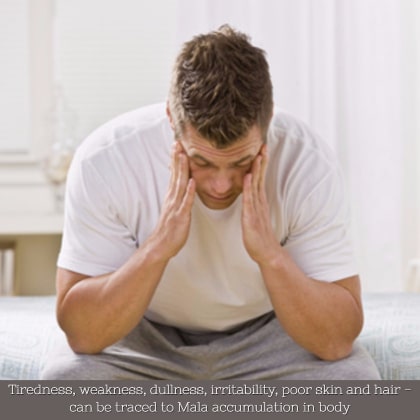
When we sleep at improper times, or we sleep too late, or at the wrong time or for too long, we impair the process of repair, regeneration and renewal in our body. So the organ systems in our body are carrying excess toxins, debris or dead cells. They may be long due for a “tune up” and have not been given the opportunity to do so because we have not slept. As a result, our body functions poorly at a sub optimal level.
The importance of Sweda / sweat and its role in overall health:
When we suppress the excretion of Mala dhatus like Sweda (sweat) from the Skin, this also leads to dis-ease. Sweda can be suppressed by using products like anti-perspirant deodorants, by artificially lowering the temperature (being in an air-conditioned environment) and by clogging the Srotas (fine channels of skin) and blocking the movement of Sweda. We can also disrupt Mala production from Skin by disturbing the Microbiota on skin.
The Skin acts as a support organ to support the overall removal of Mala (waste) in the body. For example, in alternative medicine, when kidney function is impaired, one alternative method that is used to support the kidney which is under strain is to encourage the discharge of Sweda / sweat from the skin – this is done by slowly increasing house work, by ensuring patient sleeps in a room without a.c / fan, etc (along with other treatments like dialysis, etc)
This is directly referenced in Ayurveda in Vega Dharana chapter – chapter on suppression of natural urges. When we constantly suppress the urge to pass urine, this leads to difficulty in freely passing urine. One of the therapies suggested for this condition is “Swedana” – promoting Sweating / perspiration through various means to support this discharge of Mala from the body.
Snana / Ayurvedic bath– the Ayurvedic tool to remove Mala from Skin
The Ayurvedic texts list out the large and small orifices in the body in great detail and also enumerate the mala (impurities) that accumulate as a part of normal wear and tear from the dhatus in these orifices. Moisture of the tongue, eyes, mouth, excretions of the eyes, ears tongue, teeth, axilla, genitals, pimples, greasiness of facial skin, sweda (sweat) , sebum secretions of kesha (hair) are all mala from the dhatus (tissues).
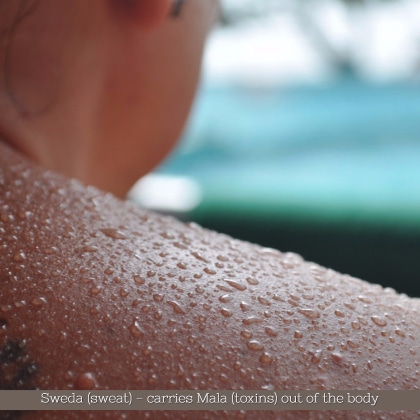
If this mala is not removed periodically, especially in seasons where the mala can increase, the body loses its health and appearance of well being. It is only by thorough cleaning these minute pores, and removing debris and dead cells that could clog these channels, can the body be truly clean.
The Mala or toxins from many organ systems find their way to our Skin. From the skin, they are released outside through the outpouring of Sweda or sweat. Sweda contains Mala from the body in the form of oil, debris, dead cells, vapour or gases and debris of micro flora or the small organisms that live on us. This is generated everyday as we sleep through the normal process of cell and organ system repair and regeneration.
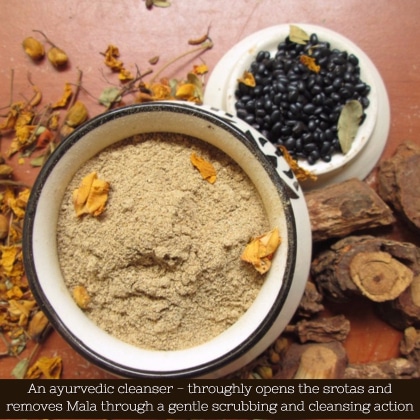
To cleanse this Mala from the Skin, the Ayurvedic texts recommend using a specific combination of lentils, grains and specific herbs that suit each kind of prakriti. The action of this cleansing product is extremely subtle – unlike a synthetic soap, the Ayurvedic Snana product opens up the pores of the skin, encouraging the removal of Mala through the srotas of the skin. The most minute pores of the skin are gently encouraged to open up and this opening action helps suck out Mala which adheres to the Ayurvedic ubtan as it cleanses the skin. Finally when the skin is rinsed with water, the entire body is left feeling refreshed, lighter, deep cleansed and ready for the new day.
This sounds great – what is wrong with having an evening Snana? Can I not get this cleansing then?
There is absolutely nothing wrong with having an additional evening Snana. In fact the Vedic texts, the “Grihya Sutras” carry more than 79 references to bathing ritual and stipulate a schedule of 3 baths a day, along with ritualized washing.
However, the morning Snana is a sacred Nithyakarma. It performs the extremely important task of cleansing the body of the Malas that are accumulated during sleeping. This Mala load is high on the body during periods of stress, high mental and physical activity, and during times of challenges and growth. If you have eaten on time and slept on time and have enjoyed a good quality of sleep, then your body would have aggressively used your sleep time to repair itself. So when you wake up in the body, all the debris from this cleansing will be present on your skin, ready to be removed through the act of Snana.

So by removing this Mala in the morning, you are setting yourself up for a good day ahead. In contrast, if this Mala is not removed, it will mean that your body will have to carry this load much longer impacting your whole day.
Can I have a different weekend routine? I wake up at noon during weekends. Can I have my bath just before lunch on weekends alone?
Your body does not recognise the difference between weekdays and weekends. Repair, and renewal and all the rules of health apply on Sundays and Mondays. If you want health, then you need to stick to the same schedule no matter the day of the week or whether you are on holiday.
I live abroad. Here people prefer to have a bath at night before sleeping and not in the morning. What should I do?
Acharya Vagbhatta says that no matter where you live, the herbs of your native place and the practices of your native place work best for you. So, if you are from India, doing your Nithyakarma no matter where you live, makes sense.
Besides, what we have said about Mala removal and cleansing the body is the same whether you live in Chennai or in California. The body clock is the same and the time for renewal and repair is the same.
A bath signals a beginning of a particular phase in the day and not the end. So it makes sense to bathe at the beginning of the day or the beginning of the evening, not at the end. Plus as per Ayurveda a bath is energizing and refreshing and not soothing and sleep inducing, so if you want to sleep well, you should have eaten well, at the right time and gone to sleep at the right time.
Additionally, a morning bath makes intuitive sense for most people unless their cultural practices strongly advise against the same. Ayurveda is a science developed after a great deal of study, thought and developed by all seeing seers / Trikala Jnanis. we believe that it can be applied to anyone no matter where they are from. So even if you are not an Indian,as long as your cultural tradition does NOT advise against a Morning bath, you too will be benefited by a Morning ayurvedic bath.
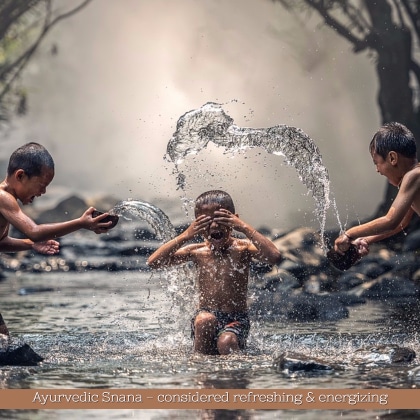
I live abroad. The local midwife and Doctor advised that I have a bath after lunch and that I give my infant a bath after lunch just before his nap. Is this okay?
In 2 words: ABSOLUTELY NOT. The shock of water on the body after eating , quells and dampens Agni , completely destroying it. Without Agni to digest the food, the food sits and ferments in your / baby’s gut and becomes poisonous and toxic. The food stays longer in the body, is not assimilated and generates a lot of Mala.
If this practice becomes a habit, the body will become weak, bloated, and listless and fall prey to disease.
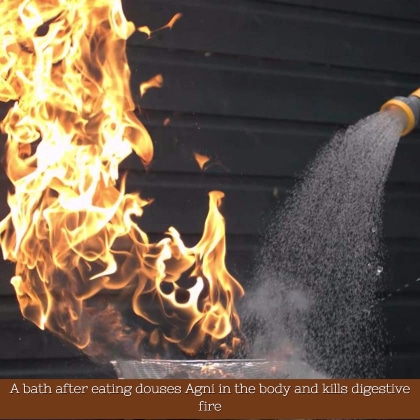
On the other hand, bathing as per your Nithyakarma in the morning, promotes appetite and enhances digestive fire. Remember there should be a gap of atleast 30 – 45 minutes between a bath and eating and bathing should be done BEFORE eating.
Should I bathe as soon as I get up in the morning?
As the Snana physically wakes up the body, the Ayurvedic texts advise that you give the body atleast 30 – 45 minutes post waking up to have a bath. The texts advice sitting in quiet contemplation in the first 30 – 45 minutes of the day and this time is suggested to be spent in isolation and in reflection. This slowly wakes up the body and prepares it for a day of activity. A bath before this, is said to send the body into a state of shock.
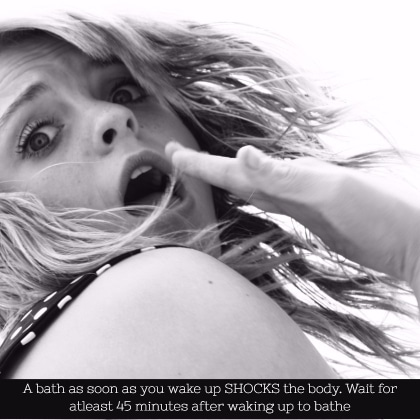
Ideally we should be waking up at dawn or just before dawn, and this time is considered extremely spiritually charged.
So once we have visited the restroom after waking up, and sat in quiet contemplation, our body is now ready for the Snana and to proceed to the next phase of the day.
Ayurvedic Bath / Snana options from Krya:
At Krya, we have a range of Ayurvedic Snana Choornams to substitute using a synthetic soap / bodywash for daily bathing. These Snana Choornams are meant for body cleansing and not facial cleansing – for facial cleansing we have a separate range of Face wash products, also in the Choornam format. Here’s an article on how to use a face wash choornam correctly.
All our Snana Choornams are ayurvedic powders made with a mixture of organic lentils, organic grains and ayurvedic herbs. Every ingredient is brought raw and whole – we individually process each ingredient to exact specifications meant for different skin needs and then blend them together to make the final products. No fragrances, surfactants, silicones, conditioning agents, or any other chemical additives are added. What you see, use and smell is the natural colour, texture and fragrance of the blend of the various lentil, grains and herbs. As the product is made as a Choornam / powder, we completely avoid using parabens, and other synthetic preservatives. Shelf life is up to one year only. If the product is stored well, it can be used for a little beyond this time.
Prakriti and Need based Snana Choornams from Krya:
- Krya Classic Plus Body wash powder : Formulated for high Pitta aggravation – helps in high body odour, burning sensation on skin, prickly heat, etc
- Krya Classic Body wash powder: Formulated for moderate Pitta aggravation: helps in sour sweat, skin greasiness, and moderate body odour
- Krya Anti acne Body wash: For those prone to Acne on back, Chest, etc.
- Krya After Sun Bodywash: for those who are easily sun burned, Sun sensitive or spend a lot of time outdoors
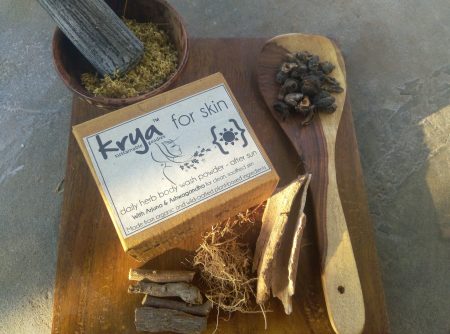
- Krya Moisture Plus Bodywash: For those with skin which is usually dry, cold, and with less hydration
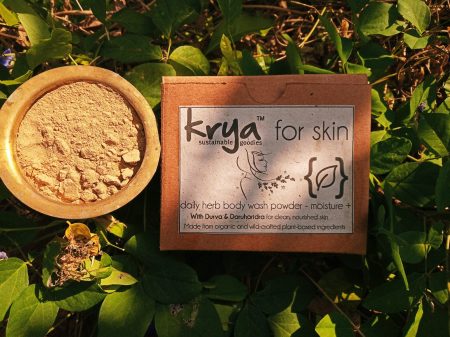
- Krya Sensitive Skin Bodywash : For those with eczema, psoriasis or dermatitis
- Krya Men’s Bodywash: formulated for Men who typically have higher levels of swetaing, skin greaisness and also high sun exposure
Lifestage based Snana Choornams from Krya:
- Krya Dauhridini Bodywash : Formulated with pitta balancing, soothing and mangalya herbs for Pregnant women
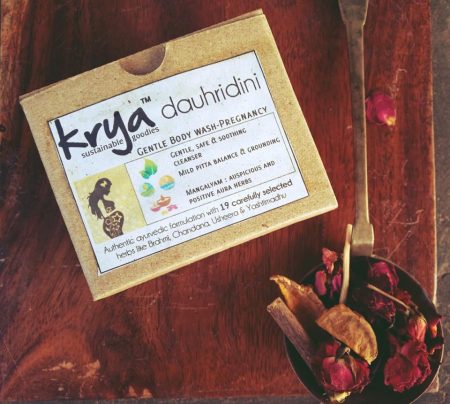
- Krya Gentle Baby Bodywash Powder : for babies between 0 – 1 years
- Krya Toddler Bodywash powder: for children between 1 – 3 years
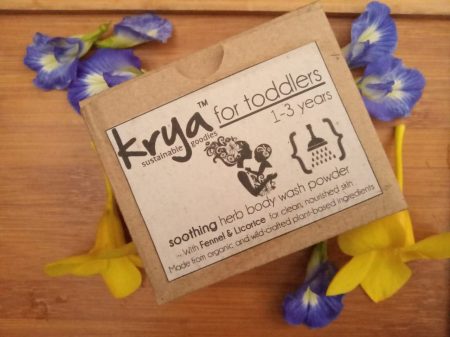
- Krya Toddler Bodywash powder (sensitive): For children between 1- 3 years with sensitive skin conditions like eczema and dermatitis
- Krya Kids Bodywash: Unisex bodywash for Children above 3 years
- Krya Teens Bodywash: formulated for Teens with acne, skin greasiness, moderate body odour and sun tanning / burning
Apart from these Snana Choornams / Ayurvedic body wash powders, we also have a range of Ubtans for Abhyanga Snana. They are to be used along with our Abhyanga oils and help remove oil better. Krya’s Ubtans are tailor made for Snana after abhyanga to ensure that the body does not get too cold, oil is properly cleansed and Vata is kept under check. These are recommended only post Abhyanga and not on “dry skin”.
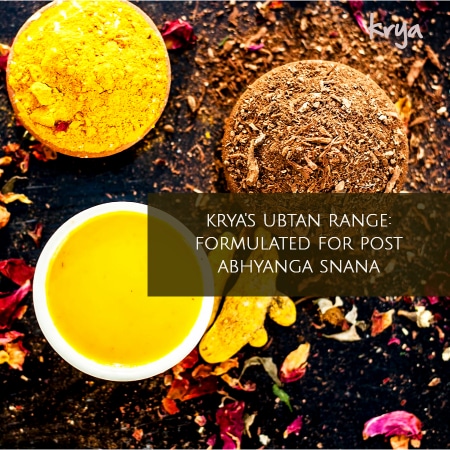
Some benefits observed with an Ayurvedic bath at Krya:
- There is better thermo-regulation of the body: in many of us, due to the constant use of AC, and synthetics on Skin, the fine Srotas are clogged leading to reduction of sweat and therefore impaired thermo-regulation. Once you start using our Snana Choornams / Ayurvedic bath powders, you will find that your sweating is more regular, if it has been impaired before.
- Reduction in excessive sweating: When Pitta is aggravated, we see issues like excessive sweating. While this needs to be addressed at an overall level, switching to our Snana Choornams helps control this to some extent
- Reduction in intensive body odour: Body odour occurs due to unchecked Pitta dosha. As we use Pitta balancing herbs in our formulations, over time people notice a marked improvement in intensity of body odour
- Improvement in skin texture: For skin that is on the dry side, constant use of soaps is extremely drying. Switching to natural Snana Choornams / Ayurvedic bath powders with vata balancing herbs and without harsh surfactants and additives makes a huge difference in skin. Many people in fact discover that their skin is not as dry as they assumed it was.
- Better skin healing: in conditions like dermatitis and eczema, the use of cleansers can severely irritate skin leading to outbreaks. This is brought under control when our product is used – most users report having instant relief, reduction in itchiness etc. If this is supplemented with proper diet and ayurvedic medication even chronic psoriasis, eczema, etc can be brought under control.
- Skin does not feel dry, taut or tight after a bath: Synthetic soaps and bodywashes over cleanse skin stripping it of natural oils. This does not happen with herbal bodywash products.
- Feeling of well being , freshness and lightness : this has everything to do with the nature of the product and the healing effect of the herbs used
To sum up: A Perfect Ayurvedic Bath
A synthetic soap only cleanses superficially and uses strong artificial fragrance that lull you into feeling that you are much cleaner than you actually are. The Ayurvedic Bath / Snana, on the other hand, is an excellent daily rejuvenative, detoxifying and cleansing and purificatory ritual that is best done in the morning at a quiet time.
When done with the right Ayurvedic lentils, grains and herbs, it thoroughly cleanses and purifies the entire body without stripping the skin of its essential oils.
Ayurveda , despite having very sophisticated manufacturing processes did not explore using Lye based foaming products like soaps for an ayurvedic bath. Instead, our acharyas encouraged us to formulate ayurvedic bath powders using various herbs, lentils, grains, and clays to do a subtle yet thorough cleansing of the skin and overall rejuvenation. Emphasis was laid on minutely cleansing the Skin’s channels / srotas , unplugging dirt and sebum from them, without weakening them or wiping out our Microbiota. Beautiful skin healing and pH adjusting herbs like Mulethi, Brahmi, Rose, Vetiver, Mushta, etc were used to craft this Ayurvedic bath powder.
We hope this post made you a bit more aware of the ayurvedic bath tradition. We also hope it inspired you to take a good hard look at any bathing synthetics you now use, and switch to an ayurvedic bath power instead.
If you need help choosing any Krya product, please write to us: [email protected]

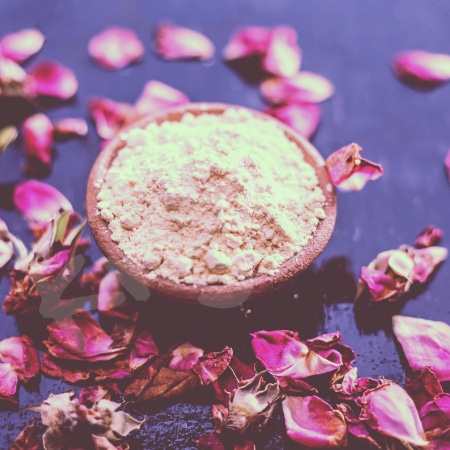




thanks for all informations.Would ask what type of herbs or spices can we put in our bath water
Interesting question – will do a separate post on this soon.
thank you for expounding this knowledge
Thanks Mouxja!
What are the diet rules on the day of oil bath, for different prakruthi men and women